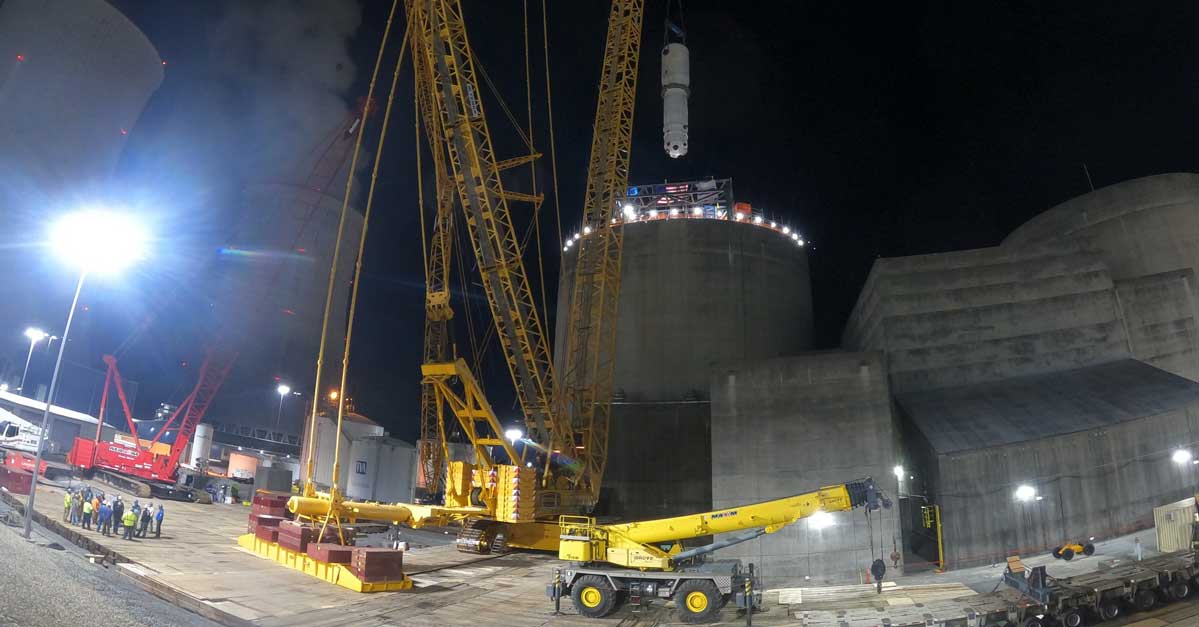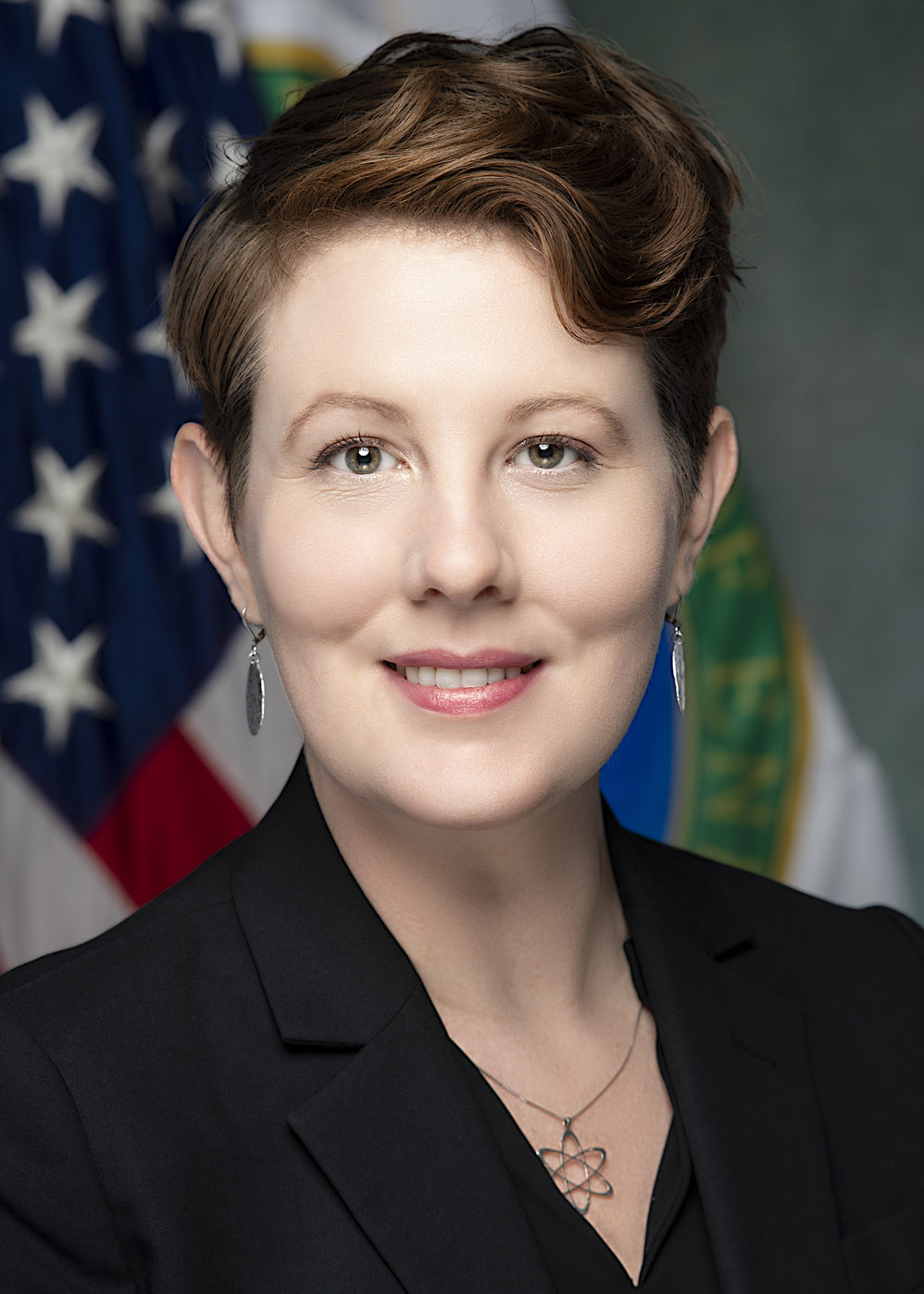From left: Romanian minister of energy Virgil Popescu, U.S. Export-Import Bank president and chair Reta Jo Lewis, Romanian president Klaus Iohannis, U.S. special presidential envoy for climate John Kerry, and U.S. State Department assistant secretary Geoffrey Pyatt. (Photo: ExIm)
The Export-Import Bank of the United States has issued two letters of interest (LOIs) for the financing of U.S.-sourced pre-project technical services in connection with the proposed reactor construction project at Romania’s Cernavoda nuclear plant, the bank announced last week.
Centrifuge casings arrive in Piketon, Ohio. (Photo: Centrus Energy)
The Department of Energy announced a cost-shared award on November 10 valued at about $150 million for American Centrifuge Operating, a subsidiary of Centrus Energy, to complete the high-assay low-enriched uranium (HALEU) demonstration project it began in 2019. After delays that Centrus attributes in part to the COVID-19 pandemic, the company now has until the end of 2023 to produce the first 20 kilograms of HALEU enriched to 19.75 percent U-235 from the 16-centrifuge cascade it has installed in a DOE-owned Piketon, Ohio, facility—the only U.S. facility currently licensed to produce HALEU.
A steam generator is lifted into Watts Bar Unit 2. (Photo: Framatome)
The Steam Generating Team (SGT)—a joint venture of Framatome and United Engineers & Constructors Inc.—has completed a project to replace the Unit 2 steam generators at the Watts Bar nuclear plant, Framatome announced last week.
Watts Barr’s owner and operator, the Tennessee Valley Authority, awarded Framatome the contract for the work in early 2020.
Research engineers take a sample of molten salt for the NEXT Lab. (Photo: Jeremy Enlow/Steelshutter)
The Nuclear Energy eXperimental Testing (NEXT) Laboratory at Abilene Christian University in Texas created quite a bit of buzz within the nuclear community in August when it submitted the first application for a new U.S. research reactor in more than 30 years. The construction permit application submitted to the Nuclear Regulatory Commission is for a molten salt research reactor (MSRR)—the first-ever university application for an advanced research reactor. Assuming NRC acceptance of the application, which could happen this year, a formal technical review of the lab’s MSRR plan will then begin, and construction of the MSRR could be completed by 2025. The Abilene campus’s new Science and Engineering Research Center—a 28,000-square-foot multiuse facility for chemistry, physics, and engineering research and education—is expected to be completed by July 2023 and will house the advanced reactor. The final step is to obtain the NRC operating license for the MSRR and commence operation.
The opening session of ICGR-6. (Photo: OECD NEA)
While deep geological repositories (DGRs) are the globally preferred and scientifically proven solution to store high-level radioactive waste, societal challenges remain. Given the long time frames associated with DGR development and implementation, and a rise in global interest in nuclear energy to meet urgent climate mitigation targets, building and maintaining human capacity is now even more of a priority.
On the left, equipment being installed at Indian Point-3 on April 26, 1971. Unit 3 began operation in August 1976. On the right, some of the same equipment being removed as part of the decommissioning process, November 2022. (Photo: Indian Point Energy Center)
Holtec continues the decommissioning work at Indian Point nuclear power plant in Buchanan, N.Y.
Unit 2, a 1,028-MWe pressurized water reactor, was shut down in April 2020; Unit 3, a 1,041-MWe PWR, was closed one year later. (Unit 1 was decommissioned in 1974.)
The U.S. ITER Project Office in Oak Ridge, Tenn. U.S. ITER has received $256 million in Inflation Reduction Act funding. (Photo: U.S. ITER)
Just days before COP27 and the U.S. midterm elections, the White House announced $1.55 billion in Inflation Reduction Act (IRA) funding for national laboratories and the launch of a Net-Zero Game Changers Initiative based on a new report, U.S. Innovation to Meet 2050 Climate Goals. Out of 37 research and development opportunities identified, fusion energy was selected as one of just five near-term priorities for the new cross-agency initiative. Together, the announcements signal policy and infrastructure support for fusion energy—the biggest chunk of Department of Energy Office of Science (DOE-SC) IRA funding went to ITER, via Oak Ridge National Laboratory—and for advanced nuclear technologies to power the grid and provide process heat to hard-to-decarbonize industrial sectors.
ANS's “Powering Our Future: The Coal to Nuclear Opportunity” panel discussion featured (top left, clockwise) Jessica Lovering, Patrick Burke, Kenya Stump, Andrew Griffith, Christine King, and Carol Lane. (ANS screenshot)
Since at least June of last year—when TerraPower and PacifiCorp announced plans to site the Natrium reactor demonstration project at one of Wyoming’s retiring coal plants—the concept of repurposing those plants to host nuclear reactors has been a popular topic of conversation among the energy cognoscenti.
Mexico's Laguna Verde nuclear power plant, on the coast of the Gulf of Mexico in the state of Veracruz.
An agreement between the United States and Mexico on civil nuclear cooperation has entered into force, the U.S. State Department announced last week. While first proposed in 2016 and finalized and signed in 2018, the pact only received approval from the Mexican Senate this March.
A Northrop Grumman Antares rocket, with the Cygnus spacecraft Sally Ride aboard (so named for first American woman to fly in space), launched at 5:32 a.m. EST on November 7, from NASA's Wallops Flight Facility in Virginia. The rocket is captured just after liftoff in this still image from NASA’s live broadcast of the event.
Seeds from the joint laboratories of the International Atomic Energy Agency and the Food and Agriculture Organization of the United Nations (FAO) are onboard a Cygnus spacecraft launched from NASA’s Wallops Flight Facility in Virginia early on November 7. Now orbiting the Earth en route to the International Space Station, the seeds are part of a commercial resupply mission with a payload that includes resources to support more than 250 scientific investigations.
Curie and Meitner (Photos: Wikicommons)
Marie Curie was born in Warsaw in 1867 on this day, 155 years ago. Exactly 11 years later, in 1878, Lise Meitner was born in Vienna. November 7 is also the date when, in 1911, the Swedish Royal Academy of Science decided to award Curie a second Nobel Prize for her 1898 discovery of the elements radium and polonium (coincidentally, her 44th birthday). Curie, who at age 36 had shared the 1903 Nobel Prize in Physics with her husband, Pierre Curie, and Henri Becquerel, later accepted the chemistry prize on December 10, 1911. She remains to this day the only person—man or woman—to receive two Nobel Prizes in two different fields of science. (Linus Pauling was also awarded Nobel Prizes in two categories: chemistry and peace.) On this unofficial day of women in nuclear science, let’s take a moment to acknowledge the fundamental discoveries of both Curie and Meitner.



















